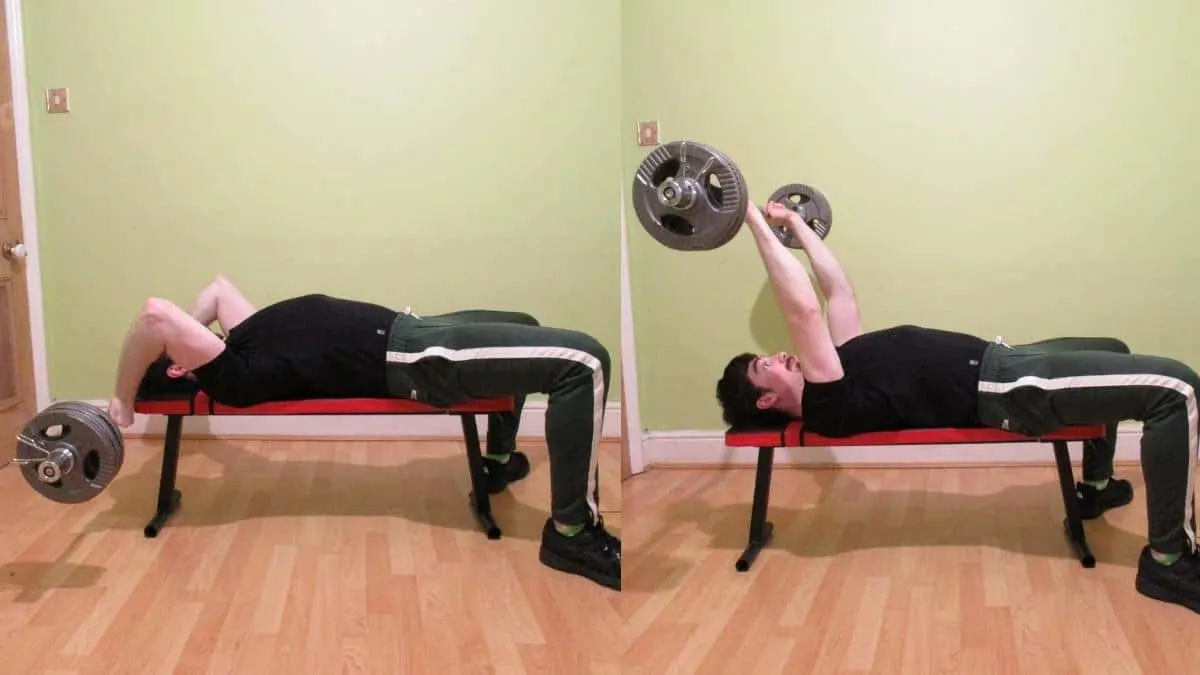No exercise builds the triceps quite like EZ bar skull crushers. And that’s because no other movement trains the long (and by far the biggest) head of the triceps to the extent that skullcrushers do.
So if you want bigger arms, a stronger bench press, and incredible tricep power, then performing a skull crusher workout on a regular basis will help you to achieve your goals.
But in order to get the most from this exercise, you have to lift with the proper skull crusher form. If you don’t, you could hurt your elbows and/or crush your face with the bar, which despite the name, is not the purpose of this exercise.
Related: Tricep pushdown vs skull crusher│Dips vs skullcrushers
EZ bar skull crusher exercise details
- Also Known As: Nosebreakers, nose crushers
- Main Muscles: Triceps
- Exercise Type: Strength
- Exercise Mechanics: Isolation
- Difficulty Level: Intermediate
- Equipment Needed: EZ bar, weights, bench
How to do skull crushers with the proper form
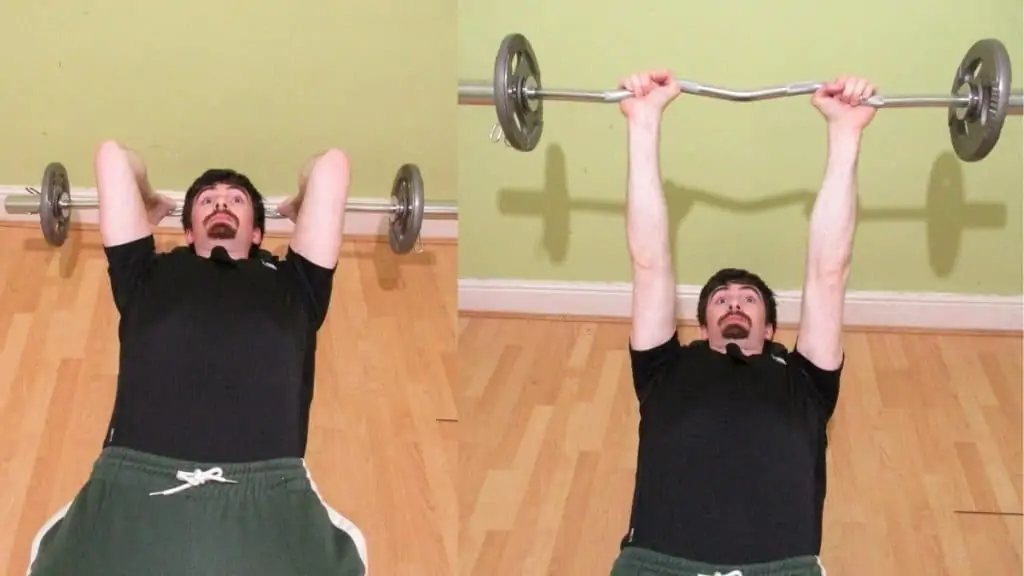
- Load a moderate amount of weight onto an EZ bar.
- Grab the bar just inside shoulder-width and then lie back on a weight bench.
- Press the bar up so that it’s directly over your face.
- Extend your shoulders back so that the bar is now in line with the end of the bench rather than with your head.
- Lower the bar behind the bench by simultaneously breaking at your elbows and moving your shoulders backward.
- Lower the bar until you feel an intense stretch in the long head of your triceps (your forearms and biceps should make firm contact in the stretched position).
- Reverse the motion by extending your elbows and moving your shoulders forward to their original starting position.
- Repeat for 3-5 sets of 10-20 reps.
What muscles do skull crushers work?

The skull crusher exercise isolates the triceps brachii to make it bigger and stronger. While the abdominal muscles are also active for core stabilization purposes, they’re not being taxed to any significant degree.
Similarly, the latissimus dorsi muscles are also somewhat active during the skullcrusher because of the exercise’s shoulder extension component. However, since the long head of the triceps is performing most of the shoulder movement, the lats aren’t a prime mover in this isolation exercise.
Skull crusher mistakes
Using the proper skull crusher form can easily mean the difference between building titanic triceps and wrecking your elbows beyond natural repair. So make sure to avoid these five skull crusher workout mistakes if you want to stay safe and gain triceps size at the optimal rate.
Lowering the bar to your head
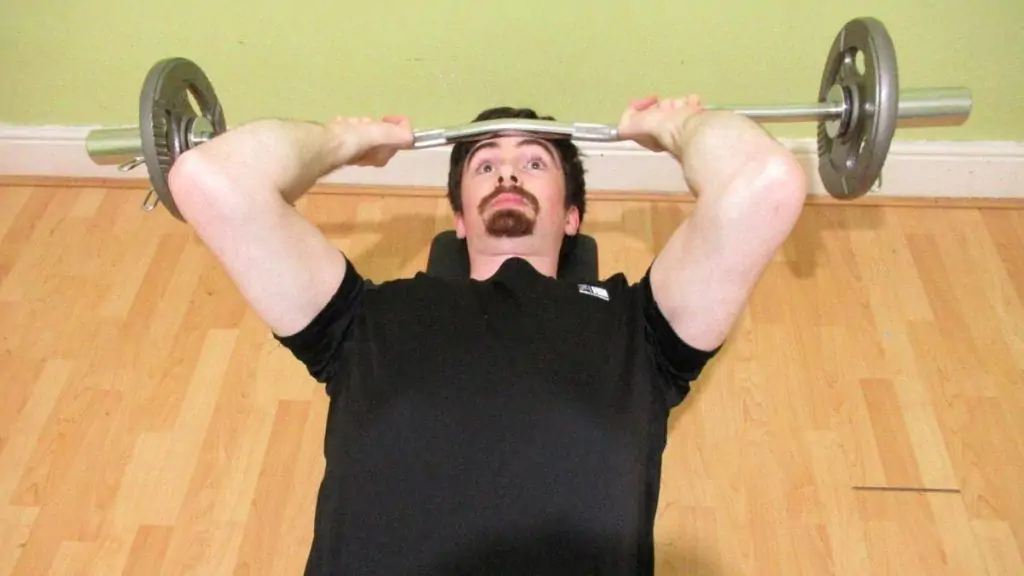
Despite the ominous names commonly given to this exercise—skullcrushers, nose breakers—you shouldn’t actually lower the bar to any part of your head or body.
If you lower the bar to your face—especially if you don’t control the descent—then not only do you run the risk of crushing your nose and/or forehead, but you’ll also be putting your elbow joints under a tremendous amount of stress.
Worse still, lowering the bar to your face arbitrarily restricts your range of motion (you can’t lower the bar through your skull!) and thus leads to lower levels of muscle activation and tricep hypertrophy.
As if all that wasn’t menacing enough, you’re also failing to put the long head of your triceps under an optimal stretch when you lower the bar to your nose rather than behind your head, or, ideally, behind the bench.
This is because the long head performs extension at the shoulder joint as well as the elbow joint. So unless you allow a liberal amount of shoulder movement during the exercise, then you’re simply not making the long head work to its full potential, which means that you’re leaving mountains of muscle growth on the table.
Not controlling the descent
What’s so bad about performing fast negatives if you’re lowering the bar behind the bench?
After all, it’s not like you can crush your forehead now that you’re using the optimal bar path, right?
While there’s an element of truth to this assumption—you can’t hurt your head if the bar doesn’t touch it—you’re still asking for elbow pain if you don’t control the skullcrusher descent.
Aggressively dropping the bar during the negative portion of the repetition in an attempt to lift heavier weights does two things: One, it robs your triceps of tension because the triceps are no longer doing the lowering, and two, it shifts that force onto your elbow joints and connective tissue structures.
So if you want your elbows to remain healthy, be extremely purposeful when you lower the bar behind your head. Aim for a 3-second negative to ensure that your triceps are bearing the brunt of the load and getting sufficient time under tension to grow bigger and stronger.
Similarly, there’s no need to “throw” the skull crusher bar into lockout as forcefully as you can because this overly aggressive action can also strain your elbows.
Instead, you certainly want to lock your elbows out on every rep because elbow extension is the primary triceps function. However, you want to perform controlled extension. Squeeze your triceps to achieve a full lockout in the same way that you’d flex your pecs during a chest fly. Doing this will keep your elbows out of harm’s way and give your triceps a better pump in the process.
Don’t you just love it when good form leads to better results?
Flaring your elbows
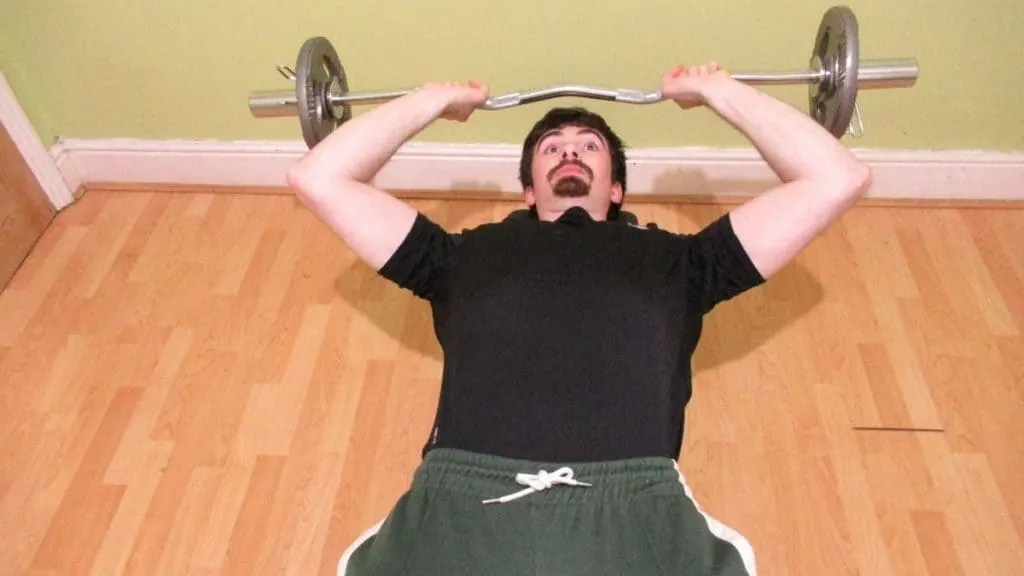
Flaring your elbows excessively during the skull crushers exercise simultaneously stresses your elbows and wrecks your wrists by shifting tension away from your triceps and onto your joints.
This is a painful double whammy that you can easily avoid by keeping your elbows in a straight line as you both lower and lift the bar.
If maintaining a rigid elbow position is too difficult, that’s a sign that you’re lifting too much weight and should probably reduce the resistance.
Using dumbbells can also help in this regard since you’ll need to hold them with a neutral grip, which is more conducive to maintaining straight elbows.
You’re not missing out on anything by avoiding the elbow flare because triceps recruitment isn’t affected by your elbow position.
Performing partial reps

Partial reps lead to partial gains.
Nowhere is this statement truer than with the triceps.
Many lifters believe that keeping constant tension on their triceps by avoiding lockout leads to better tricep development. While this unscientific practice will undoubtedly lead to a more potent pump due to the extra metabolite accumulation, it almost certainly results in less hypertrophy because you’re avoiding the primary function of the triceps: elbow extension.
Skipping the lockout portion of EZ bar skullcrushers is akin to cutting out the quadriceps flex at the top of a leg extension.
But what if full range of motion EZ bar skull crushers do hurt your elbows?
Well, this is definitely a plausible scenario for those who have fragile elbows. However, if there’s one part of a skull crusher that shouldn’t hurt your elbows, it’s the lockout portion of the rep because there’s less torque going through your elbows at lockout than during the descent.
So for best results, always perform full range of motion skull crusher extensions. Even if that means lifting less weight, your triceps and your elbows will be thankful for it.
Using the wrong rep range
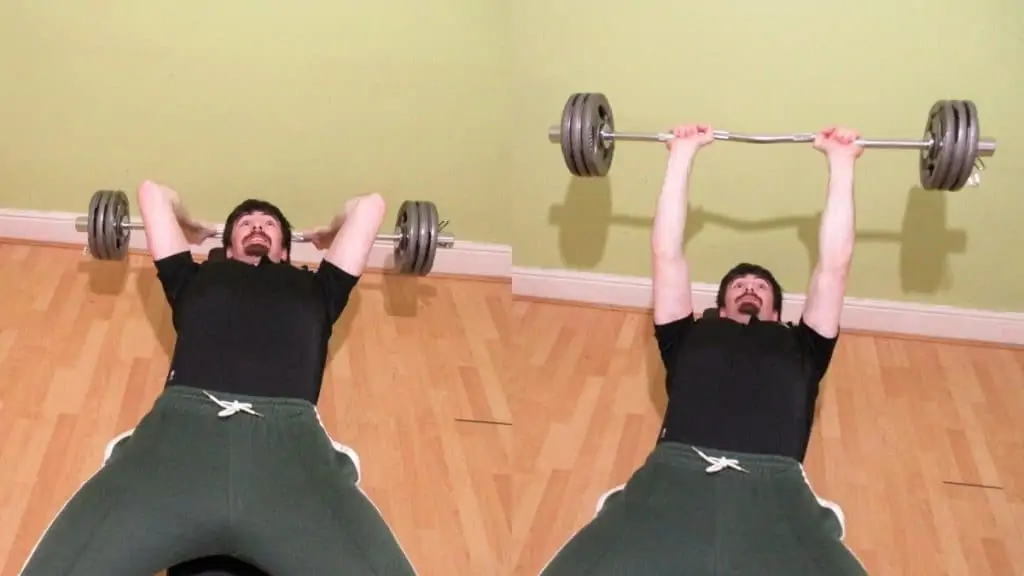
There’s no best rep range for building the triceps; as long as you’re performing sufficient training volume at a close enough proximately to muscular failure, you’ll make great gains regardless of your reps per set.
That said, we’re still left with a bit of a dilemma when it comes to picking a rep range for our skullcrusher workout.
On the one hand, you could make the case that since the triceps are composed of predominantly fast-twitch muscle fibers (more so than any other muscle group), lifting heavy weights for low reps is the best approach for stimulating optimal rates of hypertrophy.
On the other hand—and this is likely your best bet for long-term progression—using moderate to light reps and weights is a better approach because it places less stress on your elbows.
So while you may see slightly better short term progress (especially in terms of strength) by using lower reps (3-7), you’ll achieve more muscle growth over the long term by sticking with moderate to high reps (10-20) because your elbows won’t take as much of a beating.
Performing higher repetitions also enables you to accumulate the necessary training volume in fewer sets. This means that your skull crushers workout will be shorter because you won’t need to perform as many sets.
Additionally, because you’re not lifting so heavy, your rest periods will be shorter as well because higher reps are less taxing on the central nervous system (and the joints) than lower reps and thus require briefer rest periods.
Benefits of skull crushers
Now that you know how to do a skull crusher with the optimal tricep-building form, it’s time to look at the benefits that you can enjoy when you perform this exercise on a regular basis.
Bigger upper arms
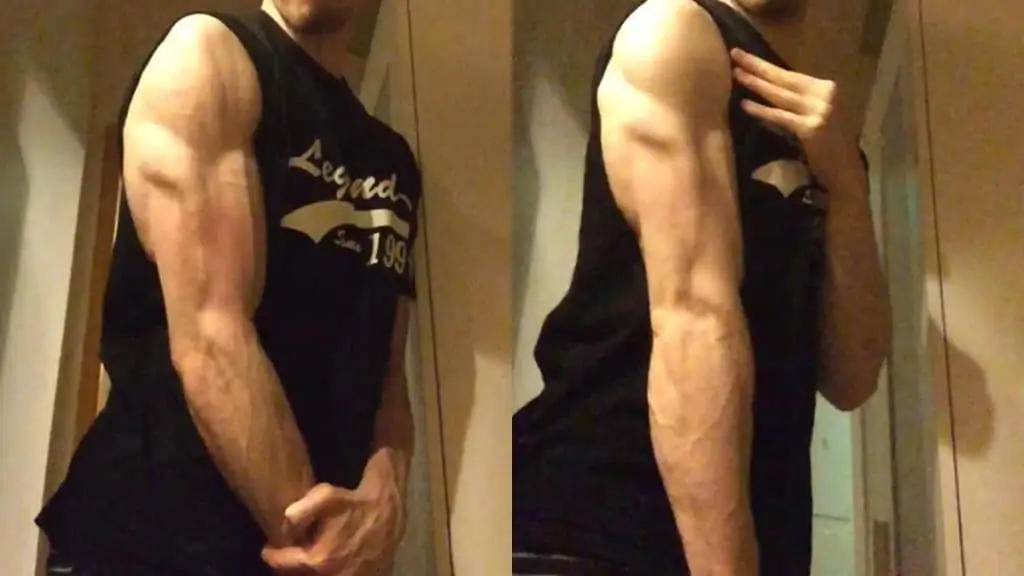
It’s commonly said by researchers and strength coaches that the triceps make up roughly two-thirds of your upper arm size. So if gaining maximum mass is your goal, then you need to make tricep training even more of a priority than blasting your biceps.
Yet, you can’t just perform any old tricep exercise and expect to achieve great results.
The EZ bar skullcrusher is the ultimate tricep builder precisely because it emphasizes the long head.
The long head is by far the most prominent tricep head (it likely makes up two-thirds of your triceps size) and the one that you need to train the most carefully because it has a dual function: elbow extension and shoulder extension.
So to bulk up your arms, make sure that you allow plenty of shoulder movement during the EZ-bar skullcrusher to maximally stretch the long head.
Stronger triceps
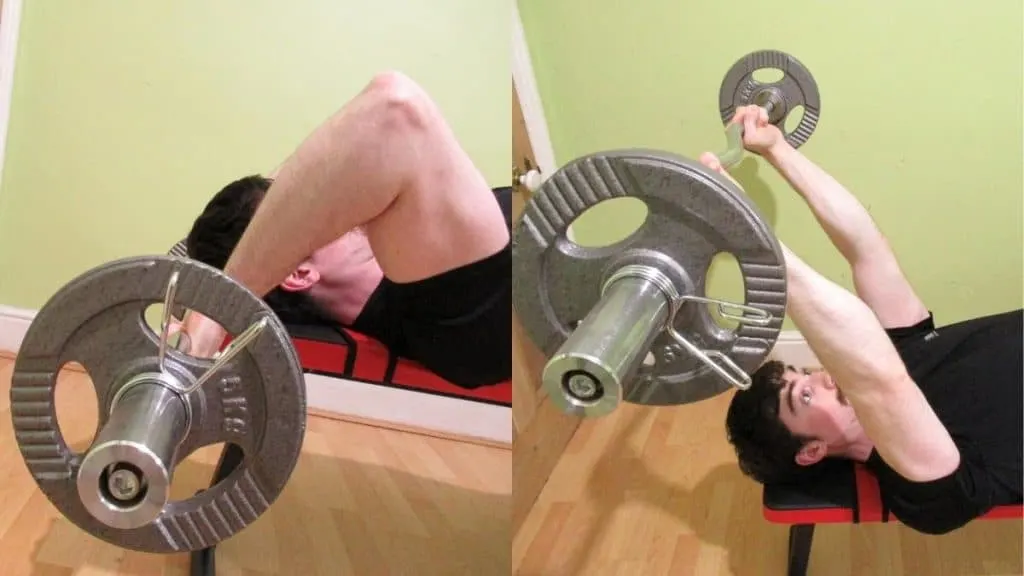
No tricep isolation exercise allows you to lift as much weight as the EZ curl skull crusher. As such, easy bar skull crushers are an excellent movement for supercharging your strength while simultaneously filling your sleeves with lean muscle.
Since this increased strength is the result of an isolation exercise—EZ curl bar skull crushers—it’ll carry over exceptionally well to all of your other tricep exercises, such as pushdowns and overhead extensions.
Just make sure to perform lying skull crushers before your other tricep movements so that you can take full advantage of its high loading potential.
Powerful press lockout

The triceps are highly active during the bench press and the overhead press, especially as your elbows reach full extension.
Given that the lockout portion of compound presses is a common point of failure for many lifters, it’s worth performing the EZ bar skull crusher if you want to improve your lockout strength because this movement trains all three tricep heads excellently.
Even if you’re a powerlifter who doesn’t care for the muscularity of their arms all that much, skull-crushers should still be a part of your program because they can help you to set new PRs by forcefully locking out your elbows at the top of a bench press.
See Also: Close grip bench press vs skullcrushers
Skull crusher variations
In addition to the EZ-curl skull crusher that you’re already familiar with, there are more than 20 other variations of the tricep skull crusher that you can perform. In this section, we’ve created mini-guides for the most popular types of skull crusher, but you can also check out our complete corpus of tutorials (by clicking on the links below) to learn about the other versions in more detail.
- 3 way skull crushers
- Alternating skull crushers
- Bodyweight skull crusher
- Cable skull crushers
- Decline skull crushers
- Floor skull crushers
- Kettlebell skull crusher
- One arm skull crushers
- Plate skull crushers
- Pronated skull crusher
- Resistance band skull crushers
- Reverse grip skull crushers
- Skull crusher to close grip press
- Smith machine skull crushers
- Stability ball skull crushers
- Standing skull crushers
- TRX skull crusher
- Wide grip skull crushers
Dumbbell skull crusher

The dumbbell skull crusher is the second most popular type of skullcrusher/nose breaker exercise and one that you should seriously consider performing if you want to sculpt symmetrical triceps.
Although you can’t lift as much weight on the dumbbell version as you can with the traditional EZ bar skull crusher, the former exercise is better for preventing upper arm size asymmetries because you have to lift each weight independently.
The dumbbell version is also easier to set up because you don’t need to spend time or energy loading any weights onto a bar.
The downside of this convenience is that you can’t easily microload dumbbells in the same way that you can microload a bar (i.e., by adding small or fractional plates to each side). As such, you won’t be able to gain strength as quickly if you make the dumbbell version your skull crusher exercise of choice.
Barbell skull crusher
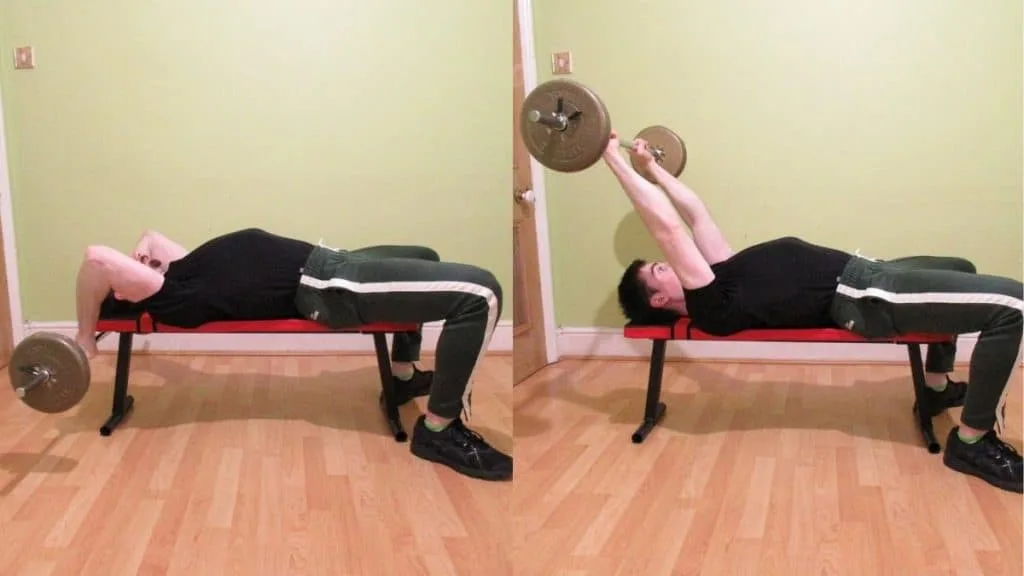
Barbell skull crushers offer all the benefits of the EZ bar skull crusher—high loading potential, straightforward progressive overload, long head emphasis—but put more pressure on your wrists by forcing you to use a fully pronated (rather than semi-pronated) grip.
This awkward wrist position won’t be a big deal if you’re a skullcrusher beginner because you won’t be lifting heavy enough weights to where the unnatural grip causes you any pain. However, as you gain strength, using a straight bar will put more and more pressure on your wrists, which will not only be painful, but it’ll also make it harder to focus on training your triceps.
So you’re best off sticking with the easy curl bar if you want to keep your wrists healthy.
Incline skull crusher
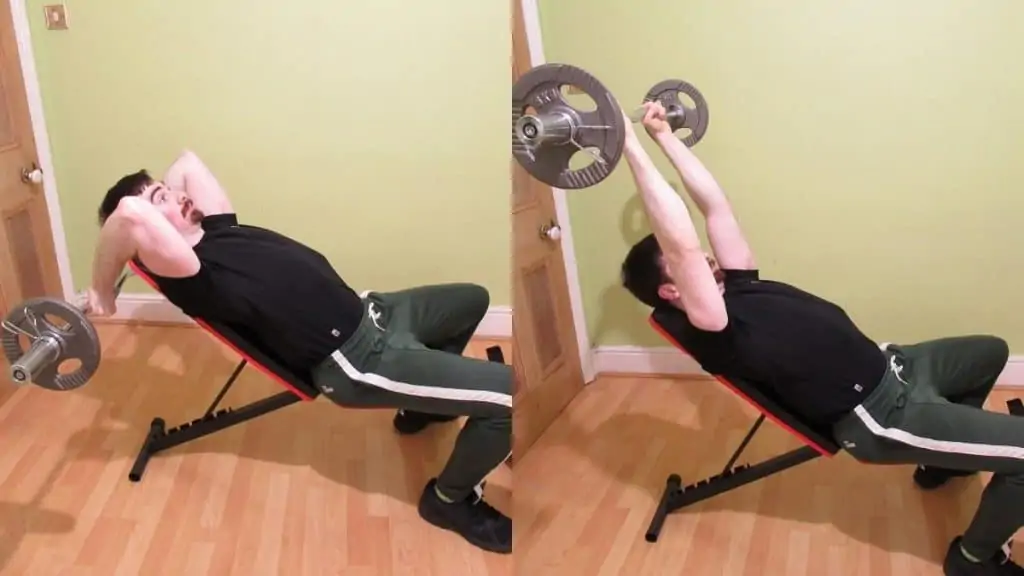
Incline skull crushers are a cross between flat bench skull crushers and overhead extensions, combining the best parts of each exercise into one prolific muscle-building movement.
The incline angle, while not necessarily superior to the flat position, forces you to lower the bar behind your head in order to get a full range of motion, which is ideal for maximally recruiting the long head.
The downside of the incline version is that you have to be careful that you don’t train to complete failure. Otherwise, you’d be forced to drop the bar from a high position, which could potentially injure other gym members who’re training close by.
Moreover, you should only attempt this exercise on a sturdy, commercial-grade adjustable bench (especially if you weigh a lot) so that it doesn’t tip back due to the combined weight of the bar and your upper body.
Skull crusher workout recommendations
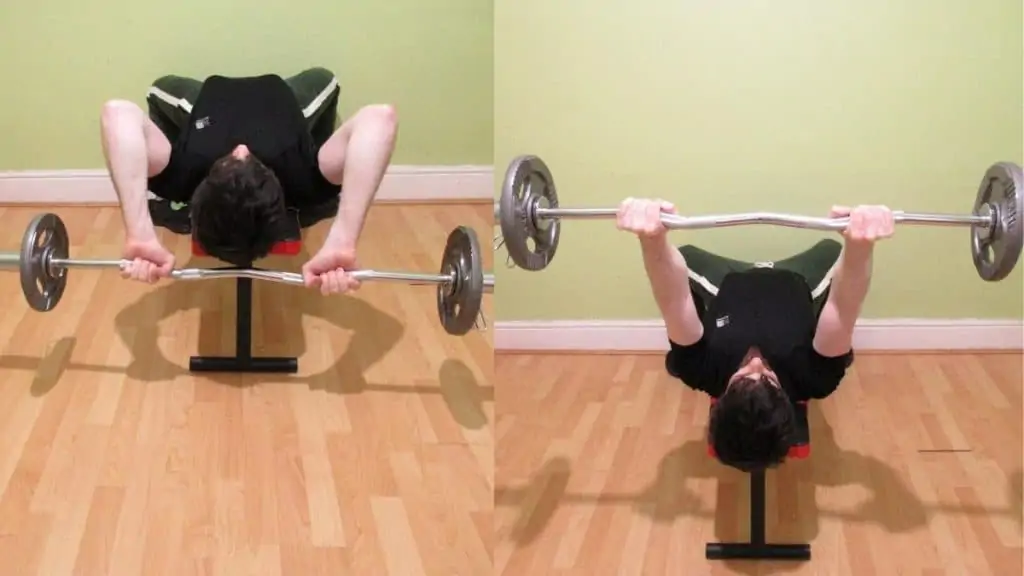
Now that you understand how to do skullcrushers correctly, you need to know how to program them within your routine.
As a general guideline, perform 3-5 sets of skullcrushers 1-3 times per week.
If this doesn’t seem like a lot of volume for a skull crushers workout, then just remember that the skull crusher shouldn’t be the only tricep exercise that you’re doing. When you add pushdowns, your compound presses, and the various cable extensions into the mix, you’ll be giving your triceps plenty of stimulation.
Beginners should start on the conservative side of the volume spectrum; 3-4 sets 1-2 times per week is ideal as performing more sets per session (3 vs 1) has been shown to stimulate stronger anabolic signaling. [1]
Advanced lifters can push the volume further to 4-5 sets per session.
While it’s possible to train muscle groups three times per week or more, this isn’t advisable for the triceps for two reasons.
First off, since the triceps are fast-twitch dominant, they respond best to heavy weights and lower training frequencies because they’re not an endurance muscle. [2]
Also, since many lifters experience elbow problems during their training careers, you simply don’t want to be putting force through your elbow joints too often because connective tissue structures take significantly longer than muscle tissue to recover. So twice per week is the highest frequency that you should use for skullcrushers.
You can, of course, perform less elbow-intensive movements on a more regular basis (see our tricep kickbacks vs skullcrushers comparison to learn more about this tricep exercise distinction).
Skull crusher FAQ
What are skull crushers?
Skull crushers, often called the nose breakers exercise, is a triceps isolation exercise that’s commonly performed by athletes and strength trainees to increase the size and strength of the muscle on the back of their upper arms: the triceps brachii.
While typically done with an EZ bar, skull crushers can be performed with a wide variety of training implements such as Olympic barbells and dumbbells.
The exercise gets its name from the fact that many bodybuilders erroneously lower the bar to their face rather than behind their head. Hence, if you were to descend with the bar too quickly or, worse still, drop the bar altogether, then you could crush your head.
This potential danger is why it’s always recommended to control the weight (lower the bar slowly) and lower it well behind your head rather than to your forehead.
What is the best bar to use for skull crushers?
The best bar for skull crushers is the EZ bar, not the straight bar. Unlike a straight bar, which forces you to use an unnatural, fully pronated grip, the EZ bar allows you to take some pressure off your wrists by using a more comfortable semi-pronated grip.
Another good bar for the skull crusher exercise is the aptly named triceps bar. This bar has wrist-friendly neutral grips that are ideal for skull crushers because they enable you to maintain straight, rather than flared, elbows at all times.
The EZ bar is still most recommended since it’s more common in gyms than the triceps bar. So if you visit a different fitness facility that doesn’t have a triceps bar, you won’t need to sacrifice your progression if you’re using an EZ bar because these bars are far more commonplace.
What is the best way to do skull crushers?
The best way to do skull crushers for both maximum safety and hypertrophy is to lower the bar behind your head in general and behind the bench in particular.
From a safety perspective, this bar path, however counterintuitive it might seem given the menacing name of the exercise, will prevent you from crushing your nose and/or forehead with the weight.
From a hypertrophy point of view, allowing liberal amounts of shoulder extension puts the long head of the triceps under an optimal stretch that will yield higher amounts of muscle growth than simply flexing and extending your elbow. [3]
How wide should you grip the bar on skull crushers?
Most people will find that gripping the bar just inside shoulder width is the most comfortable hand position for skull crushers and that which enables them to best feel their triceps working.
However, your best bet is to experiment with different skull crusher grip widths to see which feels the most comfortable for your wrists, elbows, and shoulders.
Just be sure to avoid excessively wide and narrow grips because these hand positions will likely stress your joints and make it harder to feel your triceps working.
Are skull crushers safe?
Although some lifters experience elbow pain from skullcrushers, the exercise is generally safe when performed correctly.
To take the pressure off your elbows, always lower the weight behind your head rather than to your forehead. This is doubly beneficial because it protects your elbows while keeping your face out of harm’s way.
You can further reduce or nullify potential discomfort by moving your shoulders back before or at the same time as you break at your elbows so that less torque goes through your elbows and more tension stays on the long head of your triceps (the head that performs shoulder extension).
If despite these modifications, the movement still hurts your elbows, then you can seek a good skullcrusher alternative that provides comparable results.
Read More: Lying tricep extension vs skullcrushers│French press vs skull crusher
Conclusion: Should you do skull crushers for your triceps?
Anyone who wants to bulk up their arms should do skull crushers because, when performed correctly, EZ bar skullcrushers place the long head of the triceps under a tremendous, growth-provoking stretch.
Since the long head is by far the biggest head of the triceps, make sure to perform skull crushers before your other tricep exercises so that you can take advantage of the exercise’s high loading potential.
Stick to sets of 10-20 reps most of the time. While the triceps certainly grow well from lower repetitions, you don’t want to lift too heavy because doing so will put extra torque through your elbow joints and potentially put them at risk of an injury.
References
- Burd, N. A., Holwerda, A. M., Selby, K. C., West, D. W. D., Staples, A. W., Cain, N. E., Cashaback, J. G. A., Potvin, J. R., Baker, S. K., & Phillips, S. M. (2010). Resistance exercise volume affects myofibrillar protein synthesis and anabolic signalling molecule phosphorylation in young men. The Journal of Physiology, 588(16), 3119–3130. https://doi.org/10.1113/jphysiol.2010.192856
- Fuentes, I., Cobos, A. R., & Segade, L. A. G. (1998). Muscle fibre types and their distribution in the biceps and triceps brachii of the rat and rabbit. Journal of Anatomy, 192(2), 203–210. https://doi.org/10.1046/j.1469-7580.1998.19220203.x
- Kholinne, E., Zulkarnain, R. F., Sun, Y. C., Lim, S., Chun, J. M., & Jeon, I. H. (2018). The different role of each head of the triceps brachii muscle in elbow extension. Acta Orthopaedica et Traumatologica Turcica, 52(3), 201–205. https://doi.org/10.1016/j.aott.2018.02.005

